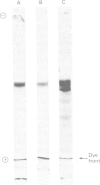Abstract
1. The purification to homogeneity of stable highly active preparations of UDP-glucuronyltransferase from liver of phenobarbital-treated rats is briefly described. 2. A single polypeptide was visible after sodium dodecyl sulphate/polyacrylamide-gel electrophoresis, of mol.wt.57000. 3. Antiserum raised against the pure enzyme produces a single sharp precipitin line after Ouchterlony double-diffusion analysis. 4. The pure UDP-glucuronyltransferase isolated from livers of untreated and phenobarbital-pretreated rats appears to be the same enzyme. 5. The Km (UDP-glucuronic acid) of the pure enzyme is 5.4 mM. 6. The activity of the pure enzyme towards 2-aminophenol can still be activated 2-3-fold by diethylnitrosamine. 7. UDP-glucose and UDP-galacturonic acid are not substrates for the purified enzyme. 8. The final preparation catalysed the glucuronidation of 4-nitrophenol, 1-naphthol, 2-aminophenol, morphine and 2-aminobenzoate. 9. Activities towards 4-nitrophenol, 1-naphthol and 2-aminophenol were all copurified. The proposed heterogeneity of UDP-glucuronyltransferase is discussed.
Full text
PDF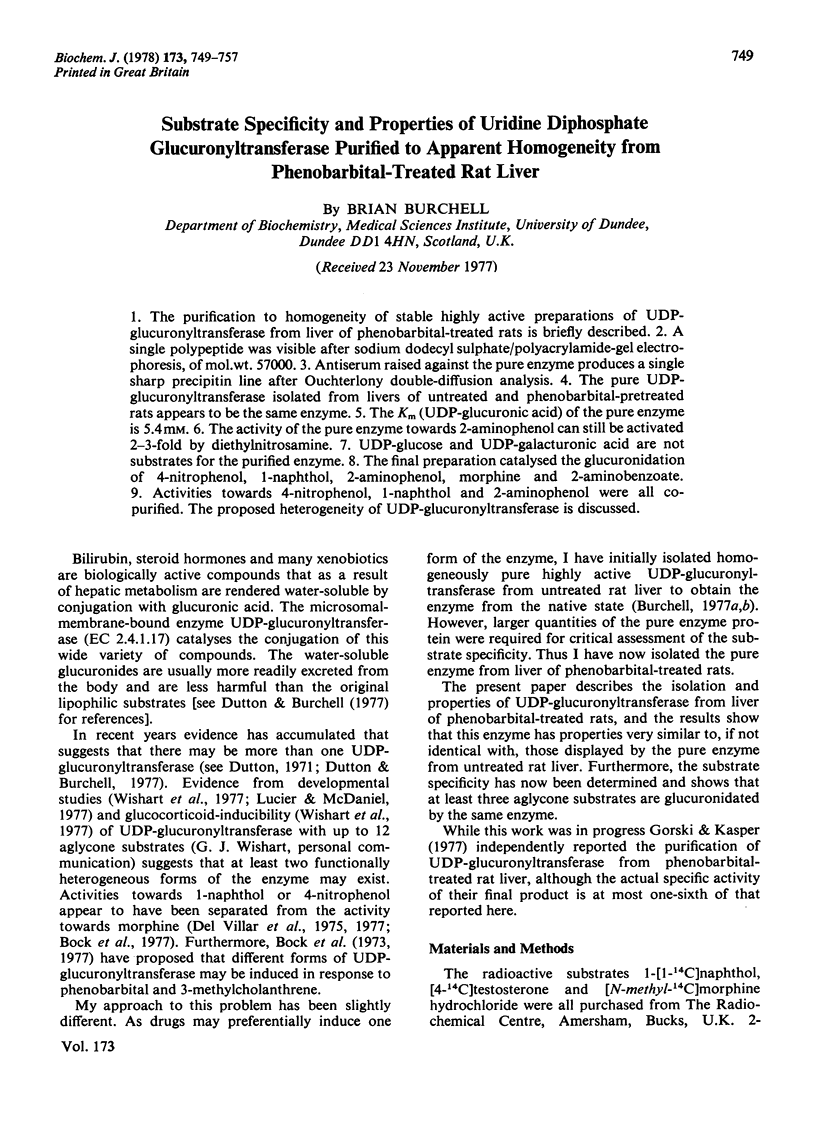
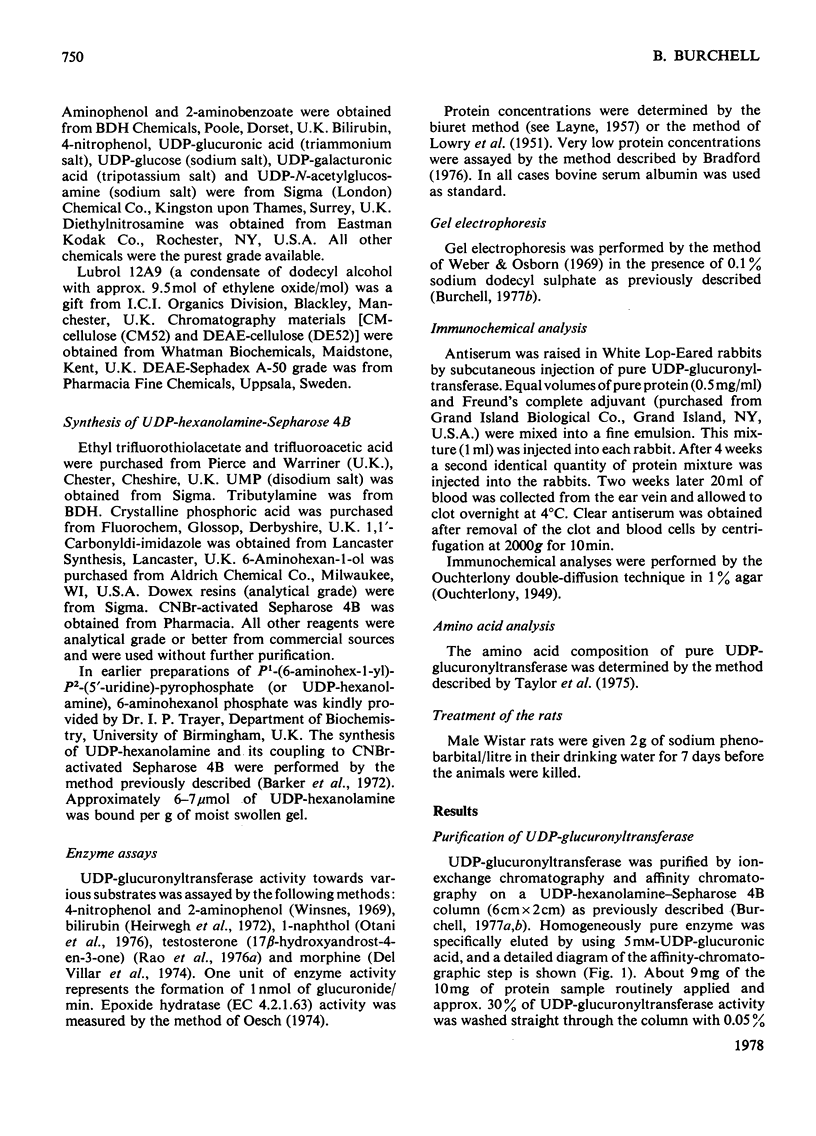
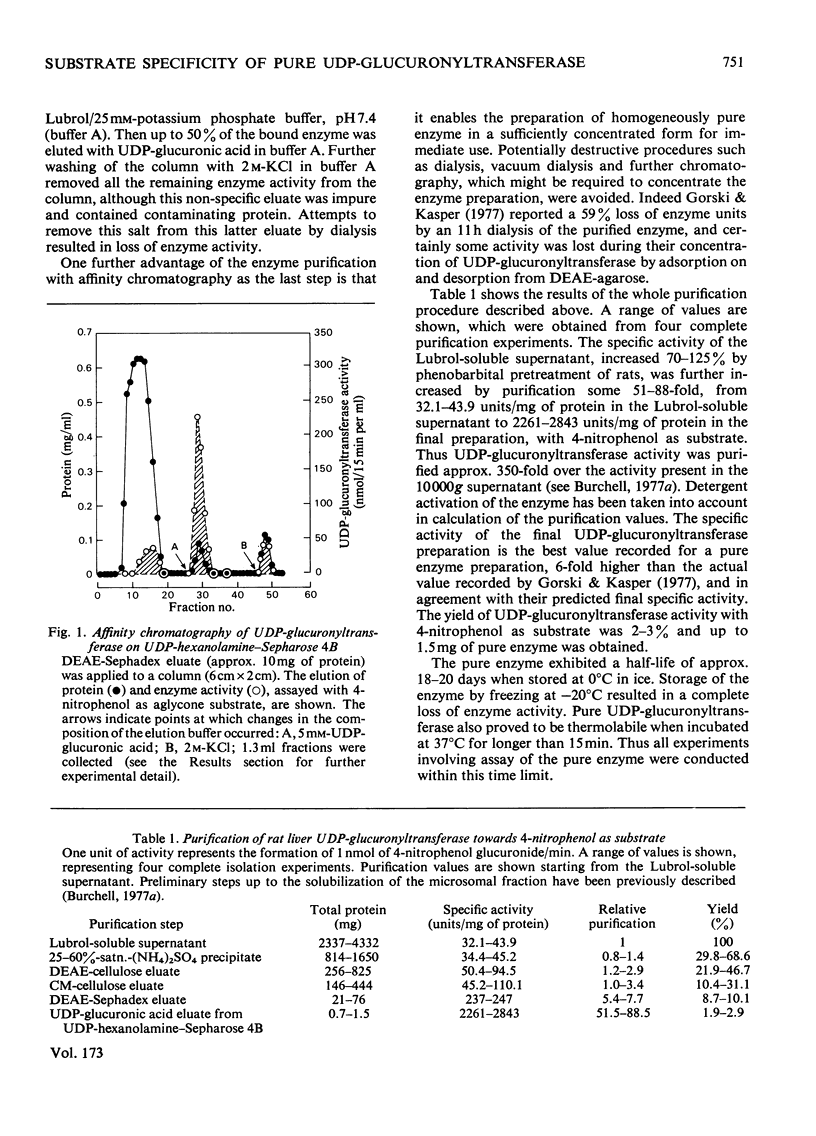
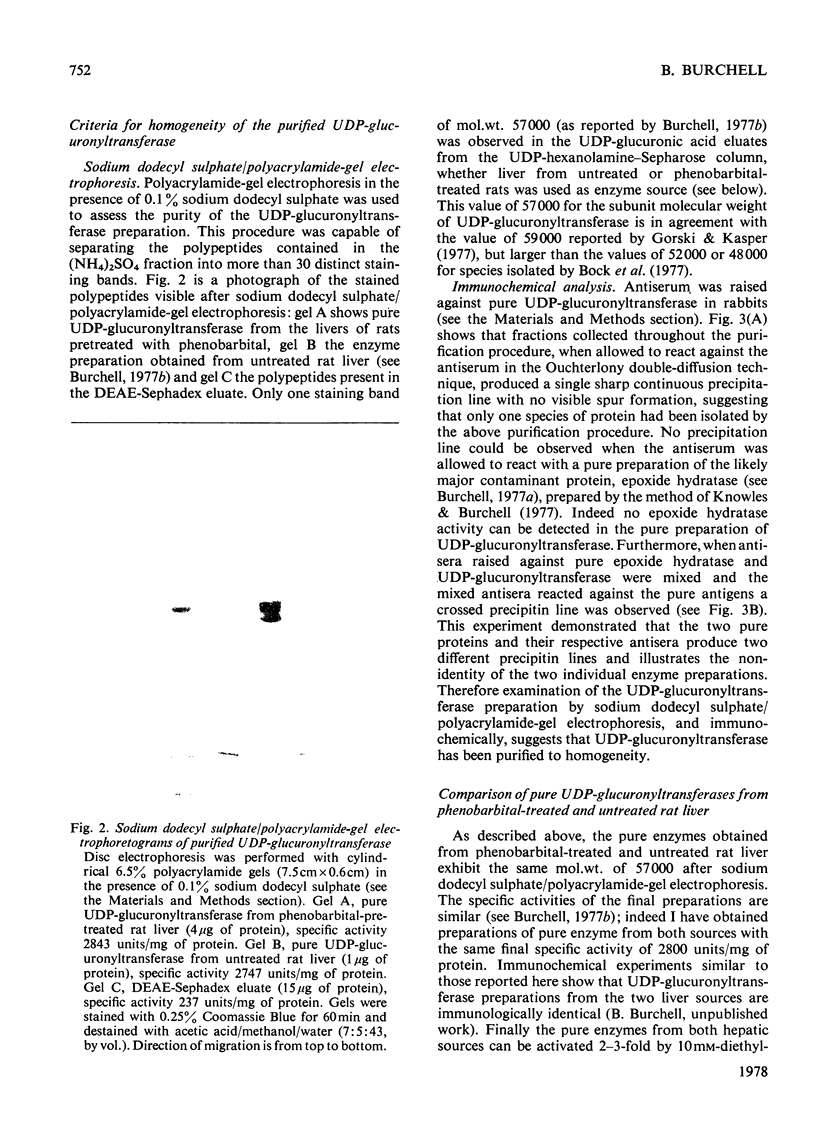
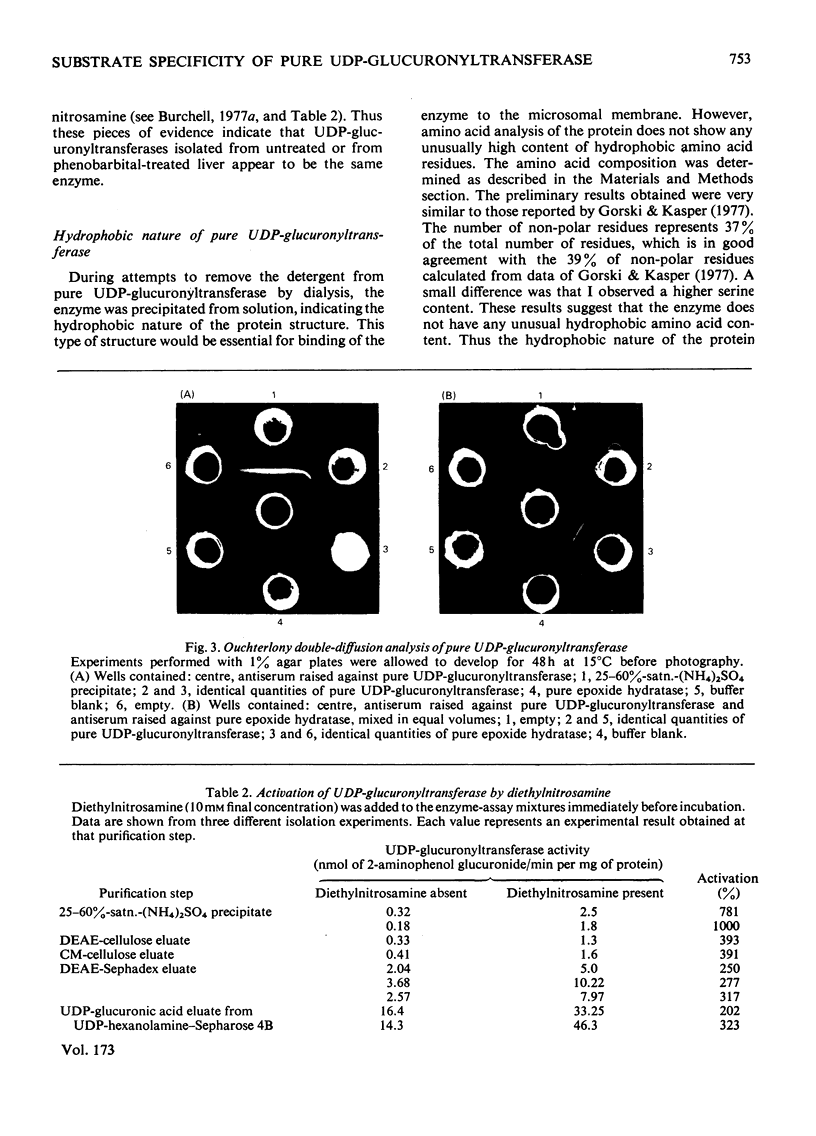
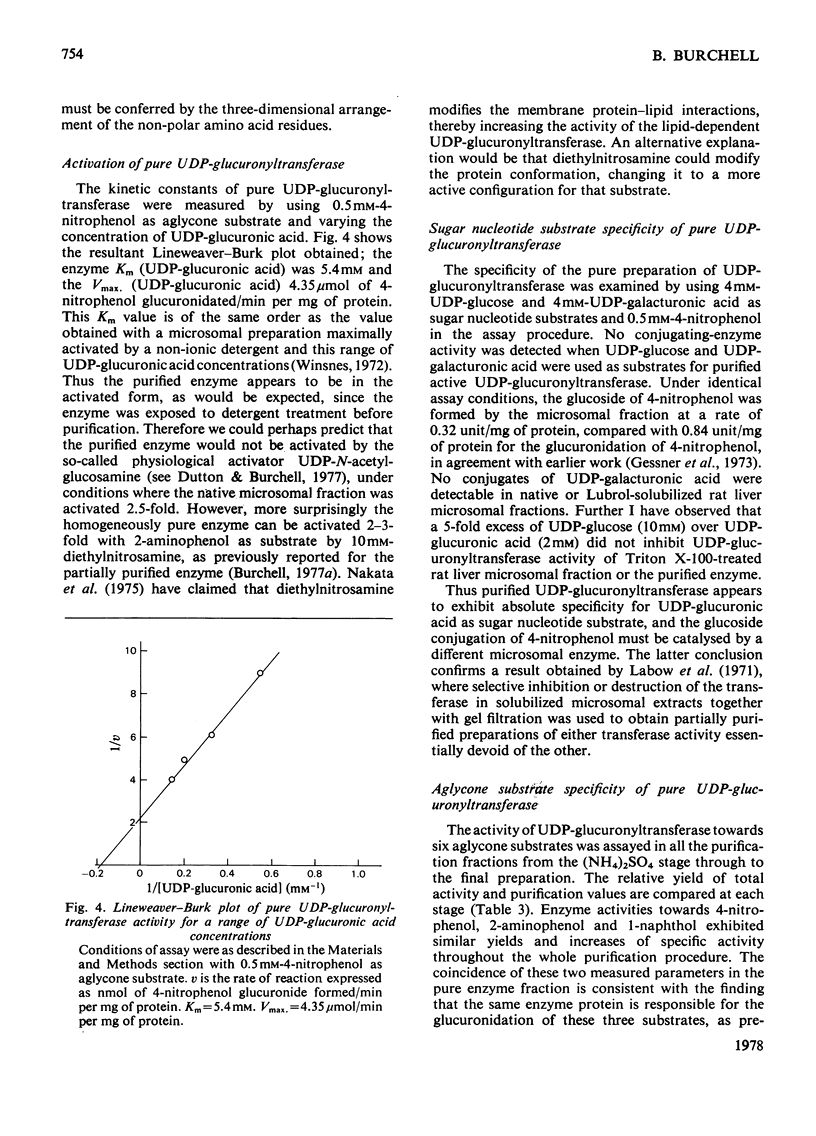
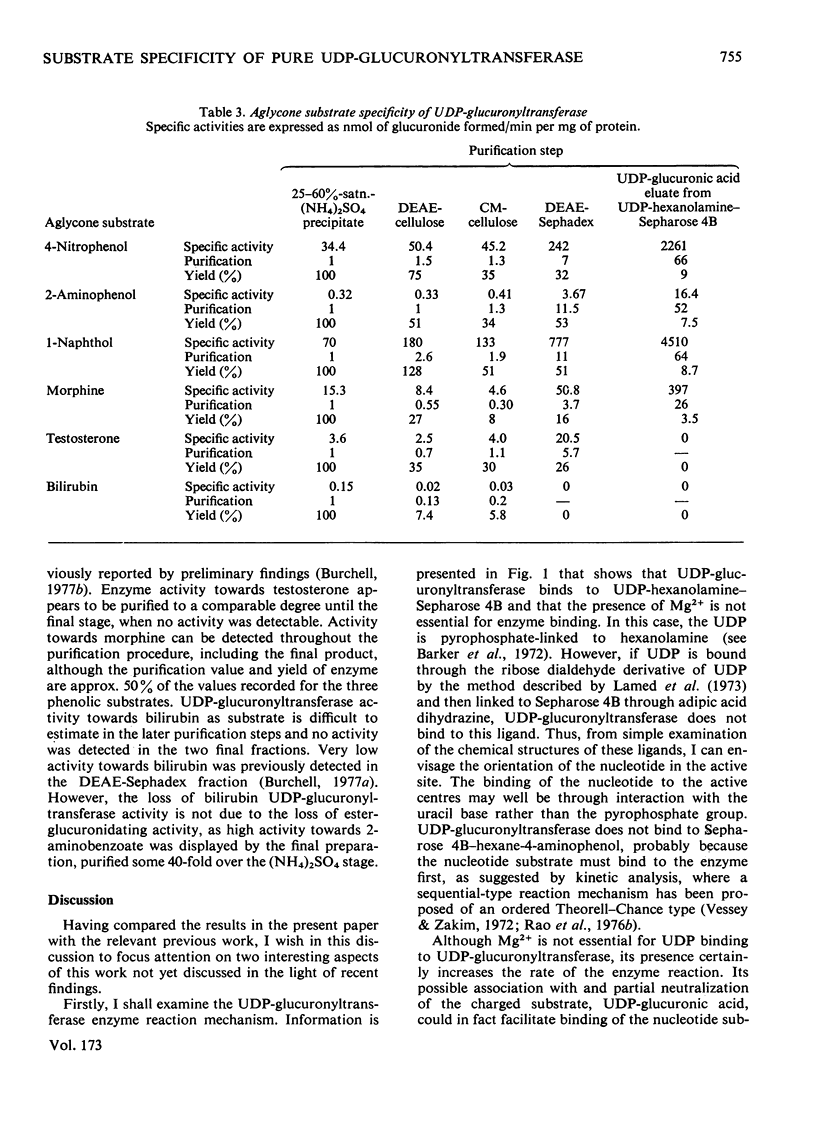
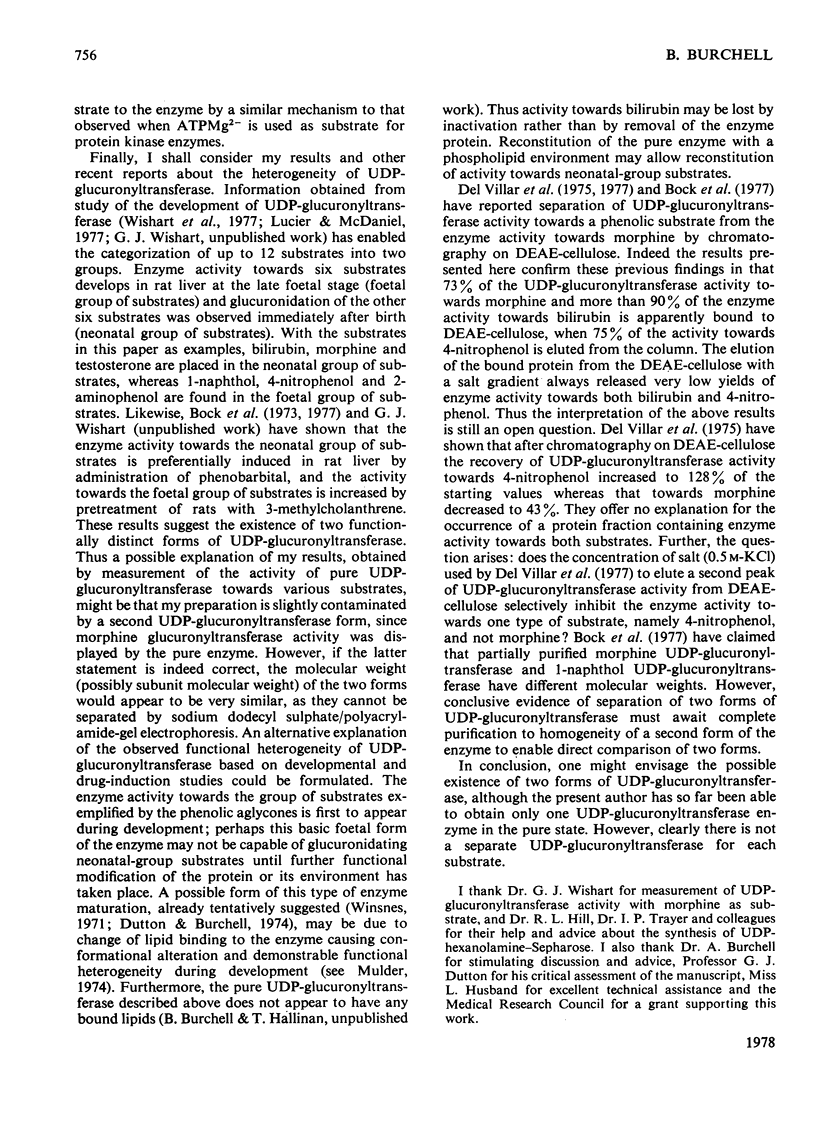
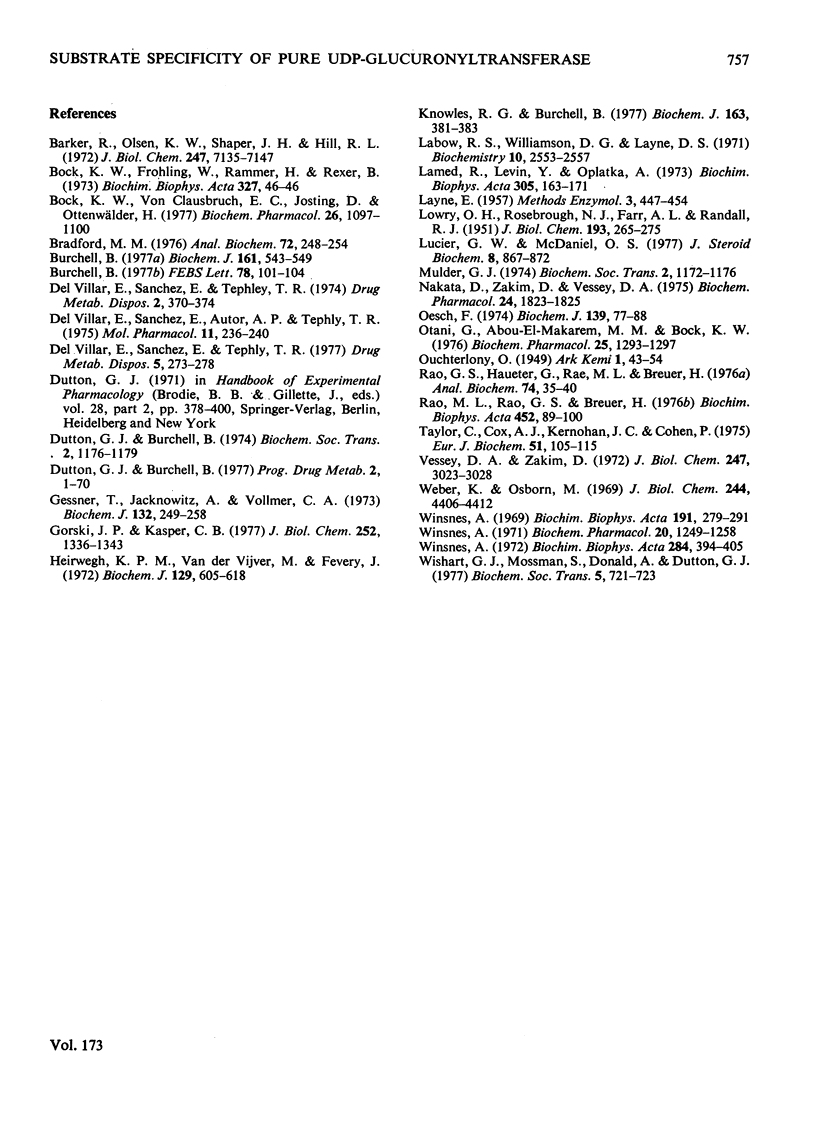
Images in this article
Selected References
These references are in PubMed. This may not be the complete list of references from this article.
- Barker R., Olsen K. W., Shaper J. H., Hill R. L. Agarose derivatives of uridine diphosphate and N-acetylglucosamine for the purification of a galactosyltransferase. J Biol Chem. 1972 Nov 25;247(22):7135–7147. [PubMed] [Google Scholar]
- Bock K. W., von Clausbruch U. C., Josting D., Ottenwälder H. Separation and partial purification of two differentially inducible UDP-glucuronyltransferases from rat liver. Biochem Pharmacol. 1977 Jun 1;26(11):1097–1100. doi: 10.1016/0006-2952(77)90254-4. [DOI] [PubMed] [Google Scholar]
- Bradford M. M. A rapid and sensitive method for the quantitation of microgram quantities of protein utilizing the principle of protein-dye binding. Anal Biochem. 1976 May 7;72:248–254. doi: 10.1016/0003-2697(76)90527-3. [DOI] [PubMed] [Google Scholar]
- Burchell B. Purification of UDP-glucuronyltransferase from untreated rat liver. FEBS Lett. 1977;78(1):101–104. doi: 10.1016/0014-5793(77)80283-4. [DOI] [PubMed] [Google Scholar]
- Burchell B. Studies on the purification of rat liver uridine diphosphate glucuronyltransferase. Biochem J. 1977 Mar 1;161(3):543–549. doi: 10.1042/bj1610543. [DOI] [PMC free article] [PubMed] [Google Scholar]
- Del Villar E., Sanchez E., Autor A. P., Tephly T. R. Morphine metabolism. III. Solubilization and separation of morphine and p-nitrophenol uridine diphosphoglucuronyltransferases. Mol Pharmacol. 1975 Mar;11(2):236–240. [PubMed] [Google Scholar]
- Del Villar E., Sanchez E., Tephly T. R. Morphine metabolism. II. Studies on morphine glucuronyltransferase activity in intestinal microsomes of rats. Drug Metab Dispos. 1974 Jul-Aug;2(4):370–374. [PubMed] [Google Scholar]
- Gessner T., Jacknowitz A., Vollmer C. A. Studies of mammalian glucoside conjugation. Biochem J. 1973 Feb;132(2):249–258. doi: 10.1042/bj1320249. [DOI] [PMC free article] [PubMed] [Google Scholar]
- Gorski J. P., Kasper C. B. Purification and properties of microsomal UDP-glucuronosyltransferase from rat liver. J Biol Chem. 1977 Feb 25;252(4):1336–1343. [PubMed] [Google Scholar]
- Heirwegh K. P., Van de Vijver M., Fevery J. Assay and properties of dititonin-activated bilirubin uridine diphosphate glucuronyltransferase from rat liver. Biochem J. 1972 Sep;129(3):605–618. doi: 10.1042/bj1290605. [DOI] [PMC free article] [PubMed] [Google Scholar]
- Knowles R. G., Burchell B. A simple method for purification of epoxide hydratase from rat liver. Biochem J. 1977 May 1;163(2):381–383. doi: 10.1042/bj1630381. [DOI] [PMC free article] [PubMed] [Google Scholar]
- LOWRY O. H., ROSEBROUGH N. J., FARR A. L., RANDALL R. J. Protein measurement with the Folin phenol reagent. J Biol Chem. 1951 Nov;193(1):265–275. [PubMed] [Google Scholar]
- Labow R. S., Williamson D. G., Layne D. S. Properties of some steroid glycosyl transferases from rabbit tissues. Biochemistry. 1971 Jun 22;10(13):2553–2557. doi: 10.1021/bi00789a021. [DOI] [PubMed] [Google Scholar]
- Lamed R., Levin Y., Oplatka A. Enzymatic mechanochemistry. I. The interaction of heavy meromyosin with "immobilized adenosine triphosphate". Biochim Biophys Acta. 1973 Apr 27;305(1):163–171. doi: 10.1016/0005-2728(73)90241-7. [DOI] [PubMed] [Google Scholar]
- Lucier G. W., McDaniel O. S. Steroid and non-steroid UDP glucuronyltransferase: glucuronidation of synthetic estrogens as steroids. J Steroid Biochem. 1977 Aug;8(8):867–872. doi: 10.1016/0022-4731(77)90096-6. [DOI] [PubMed] [Google Scholar]
- Nakata D., Zakim D., Vessey D. A. Modification of protein-lipid interactions in the Gunn rat by treatment of microsomal UDP-glucuronyltransferase with diethylnitrosamine. Biochem Pharmacol. 1975 Oct 1;24(19):1823–1825. doi: 10.1016/0006-2952(75)90466-9. [DOI] [PubMed] [Google Scholar]
- Oesch F. Purification and specificity of a human microsomal epoxide hydratase. Biochem J. 1974 Apr;139(1):77–88. doi: 10.1042/bj1390077. [DOI] [PMC free article] [PubMed] [Google Scholar]
- Otani G., Abou-El-Makarem M. M., Bock K. W. UDP-glucuronyltransferase in perfused rat liver and in microsomes - III. Effects of galactosamine and carbon tetrachloride on the glucuronidation of 1-naphthol and bilirubin. Biochem Pharmacol. 1976 Jun 1;25(11):1293–1297. doi: 10.1016/0006-2952(76)90092-7. [DOI] [PubMed] [Google Scholar]
- Rao G. S., Haueter G., Rao M. L., Breuer H. An improved assay for steroid glucuronyltransferase in rat liver microsomes. Anal Biochem. 1976 Jul;74(1):35–40. doi: 10.1016/0003-2697(76)90307-9. [DOI] [PubMed] [Google Scholar]
- Rao M. L., Rao G. S., Breuer H. Investigations on the kinetic properties of estrone glucuronyltransferase from pig kidney. Biochim Biophys Acta. 1976 Nov 8;452(1):89–100. doi: 10.1016/0005-2744(76)90060-7. [DOI] [PubMed] [Google Scholar]
- Taylor C., Cox A. J., Kernohan J. C., Cohen P. Debranching enzyme from rabbit skeletal muscle. Purification, properties and physiological role. Eur J Biochem. 1975 Feb 3;51(1):105–115. doi: 10.1111/j.1432-1033.1975.tb03911.x. [DOI] [PubMed] [Google Scholar]
- Vessey D. A., Zakim D. Regulation of microsomal enzymes by phospholipids. V. Kinetic studies of hepatic uridine diphosphate-glucuronyltransferase. J Biol Chem. 1972 May 25;247(10):3023–3028. [PubMed] [Google Scholar]
- Villar E. D., Sanchez E., Tephly T. R. Morphine metabolism. V. Isolation of separate glucuronyltransferase activities for morphine and p-nitrophenol from rabbit liver microsomes. Drug Metab Dispos. 1977 May-Jun;5(3):273–278. [PubMed] [Google Scholar]
- Weber K., Osborn M. The reliability of molecular weight determinations by dodecyl sulfate-polyacrylamide gel electrophoresis. J Biol Chem. 1969 Aug 25;244(16):4406–4412. [PubMed] [Google Scholar]
- Winsnes A. Age and sex dependent variability of the activation characteristics of UDP-glucuronyltransferase in vitro. Biochem Pharmacol. 1971 Jun;20(6):1249–1258. doi: 10.1016/0006-2952(71)90355-8. [DOI] [PubMed] [Google Scholar]
- Winsnes A. Kinetic properties of different forms of hepatic UDPglucuronyltransferase. Biochim Biophys Acta. 1972 Oct 12;284(2):394–405. doi: 10.1016/0005-2744(72)90135-0. [DOI] [PubMed] [Google Scholar]
- Winsnes A. Studies on the activation in vitro of glucuronyltransferase. Biochim Biophys Acta. 1969 Nov 4;191(2):279–291. doi: 10.1016/0005-2744(69)90247-2. [DOI] [PubMed] [Google Scholar]
- Wishart G. J., Mossman S., Donald A., Dutton G. J. Differential stimulation of foetal rat liver uridine diphosphate glucuronyltransferase activity towards certain substrates after glucocorticoid treatment in culture and in utero, and during natural development [proceedings]. Biochem Soc Trans. 1977;5(3):721–723. doi: 10.1042/bst0050721. [DOI] [PubMed] [Google Scholar]



